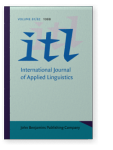The Multiple-Choice Cloze Test as a General Language Proficiency Test
Wim Jochems | Delft University of Technology The Netherlands
This article presents axsd discusses a number of empirical findings conœroing the validity of multiple-choice cloze tests as tests of general language proficiency. Foreign students of Dutch at Delft University of Technology were given both a series of separate proficiency tests in nstemng, speaking, reading, writing and text comprehension, and a series of multiple-choice cloze tests. Scores on the multiple-choice cloze tests were found to correlate significantly with each of the proficiency tests. In addition, scores made on the multiple-choice cloze tests appeared to form a solid basis for predictions of the total scores for listening, speaking, reading and writing taken together. Finally, a close structural similarity was found to exist between curves of average scores on successive multiple-choice cloze tests and the presupposed growth of vocabulary during the language learning process. Together, these findings tend to show that multiple-choice cloze tests constitute a valid instrument for measuring general language proficiency.
References
Campbeil, D.T. and Stanley, J.C.
(
1971) :
Experimental and quasi-experimental designs for research on teaching. In
Gage N.L., editor,
Handbook of Research on Teaching (171–246). Chicago : Rand McNally.

Cranney, A. Garr
(
1973) :
The construction of two types of cloze reading tests for college students.
Journal of Reading Behavior, 51, 60–64.


Farhady, H.
(
1983) :
The disjunctive fallacy between discrete-point and integrative tests. In
Oller, J.W. (editor),
Issues in Language Testing Research (311–322). Rowley, Massachusetts : Newbury House.

HiDüfotis, F.B. and Snow, B.G.
(
1980) :
An alternative cloze testing procedure : multiple-choice format. In
Oiler, J.W. and
Ferions, K., editors,
Research in Language Testing (129–133). Rowley, Massachusetts : Newbury House.

Jochems, W. and Montens, F.
(
1986) :
Hoe toets je taalvaardigheid? [
How to test language proficiency]. Meppel : Boom.

Jonz, J.
(
1976) :
Improving on the basic egg : The M.C. cloze.
Language Learnings 261, 255–265.


Lord, F.M. and Novick, M.R.
(
1968) :
Statistical Theories of Mental Test Scores. Reading, Massachusetts : Addison-Wesley.

Normally, J.C.
(
1967) :
Psychometric Theory. New York : McGraw-Hill.

Oiler, J.W.
(
1979) :
Language Tests at School, A Pragmatic Approach. London : Longman

Oiler, J.W.
(
1982) :
"g", what is it? Albuquerque : paper University of New Mexico.

Oiler, J.W.
(
1983) :
Evidence for a general language proficiency factor : an expectancy grammar. In
Oller, J.W., editor,
Issues in Language Testing Research (3–10). Rowley, Massachusetts: Newbury House.

Porter, D.
(
1976) :
Modified cloze procedure : a more valid reading comprehension test.
English Language Teaching Journal, 301,151–155.


Sciarone, A.G.
(
1979) :
Woordjes leren in het vreemdetalenonderwijs [Learning words in foreign-language education]. Muiderberg : Coutinho.

Vollmer, H.J.
(
1983) :
The structure of foreign language competence. In
Hughes, A. and
Porter, D., editors,
Current Developments in Language Testing (3–29). London : Academic Press.

Vollmer, H.J. and Sang, F.
(
1983) :
Competing hypotheses about second language ability : a plea for caution. In
Oller, J.W., editor,
Issues in Language Testing Research (29–79). Rowley, Massachusetts : Newbury House.

Wijnstra, J.M.
(
1977) :
Het gebruik van de cloze procedure als maat voor schriftelijke taalbeheersing [Use of the cloze procedure as a measure of written language proficiency].
Tijdschrift voor Onderwijsresearch, 61, 262–269.

Cited by
Cited by 3 other publications
Adrián, María Martínez & Francisco Gallardo del Puerto
del Puerto, Francisco Gallardo & María Martínez Adrián
2014.
The Incidence of Previous Foreign Language Contact in a Lexical Availability Task: A Study of Senior Learners. In
Lexical Availability in English and Spanish as a Second Language [
Educational Linguistics, 17],
► pp. 53 ff.

JOCHEMS, WIM
1991.
Effects of Learning and Teaching in a Foreign Language.
European Journal of Engineering Education 16:4
► pp. 309 ff.

This list is based on CrossRef data as of 4 july 2024. Please note that it may not be complete. Sources presented here have been supplied by the respective publishers.
Any errors therein should be reported to them.
